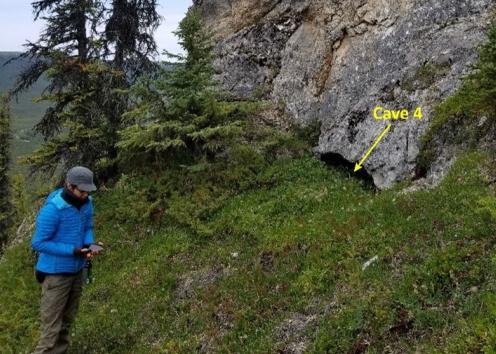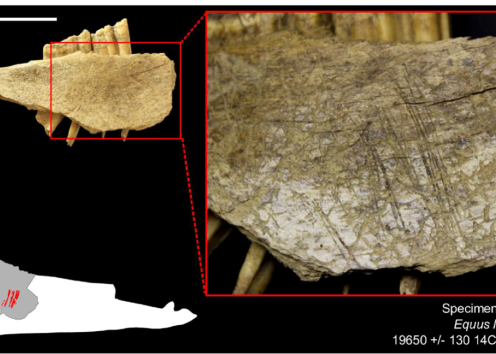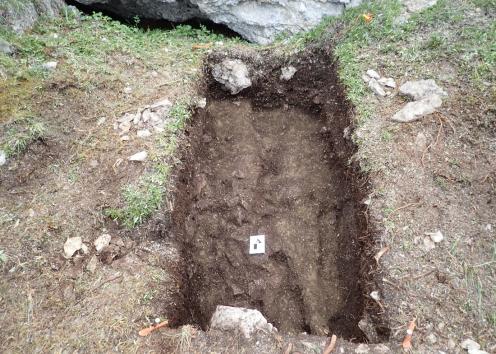Bluefish Caves

The Bluefish Caves site in the northern Yukon Territory of Canada may represent the earliest well-documented evidence of humans in North America. Bluefish Caves were excavated from 1977 to 1987 under the direction of Jacques Cinq-Mars of the Archaeological Survey of Canada. Chronological evidence from caves I and II led to the initial suggestion that human occupation of Eastern Beringia occurred before the Last Glacial Maximum, as early as 24,800 14C yr B.P. However, the stratigraphic context of the cultural deposits has been challenged, and the site formation processes need to be clearly defined.
The Bluefish Caves site is in the Keele Range about 54 km southwest of Old Crow village. The portion of the site excavated by Cinq-Mars consists of three small karstic cavities, ranging from 10 to 30 m3, situated below a limestone ridge about 250 m above the right bank of the Bluefish River. A fourth cave (Cave IV) was not excavated by Cinq-Mars and is the focus of the Odyssey Research Program.
Bluefish Caves contain a unit of loess (Unit B) up to 1 m thick above bedrock (Unit A). Unit B is mantled by a humus layer mixed with cryoclastic debris (Unit C), and finally, a modern humus layer (Unit D). Based on chronostratigraphic data from caves I, II, and III, Unit D dates to the Holocene (<11,650 cal B.P.) and the loess comprising Unit B aggraded during the late Pleistocene (>11,650 cal B.P.).
Recent taphonomic studies by KGS post-doctoral researcher Dr. Lauriane Bourgeon revealed that 15 bone samples from Caves I and II have cultural modifications confidently attributable to human activities. Six of the cut-marked bones yielded AMS radiocarbon ages ranging from 10,490±55 14C B.P. to 19,650±130 14C B.P. (12,000 to 24,000 cal B.P.) and are consistent with previously reported radiocarbon ages for Bluefish Caves.
Odyssey Fieldwork at Bluefish Caves
In 2019, Odyssey conduct limited archaeological testing at Cave III to determine whether cultural deposits occur and are in direct association with the remains of Pleistocene fauna. Also, a survey was conducted to locate cave IV. Caves I and II were inspected, but it was determined that most, if not all, of the late-Quaternary deposits within and in front of the rockshelters had been removed during previous archaeological excavations. At cave III, however, most of the deposits were intact. Jacques Cinq-Mars excavated only a single trench in that rockshelter, and the trench, which is 1 m wide x 5 m long, was never backfilled. The Odyssey team focused on the open trench.
Archaeological testing in the west wall of the abandoned trench exposed many bones of Pleistocene mammals, especially remains of horse and caribou. Also, nearly 150 bones and bone fragments were recovered during the screening of the sediment. However, no lithic artifacts were recorded. Bones recovered from Cave III are at the Kansas Geological Survey and are being inspected for butcher marks.
The reconnaissance of the area around caves I and II resulted in the discovery of cave IV. The entrance and interior of cave IV are almost completely filled with sediment; hence, there is a high potential for intact cultural deposits in this rockshelter. Cave IV, therefore, was targeted for testing by Odyssey in the summer of 2022.
In the summer of 2022, the Odyssey research team returned to Bluefish Caves and began archaeological testing at cave IV. Two contiguous 1 x 1 m test units were opened immediately in front of the cave, both reaching a depth of about 1 m. However, the bedrock floor of the cave was not exposed. The depth to bedrock in caves I and II sometimes reached nearly two meters; hence, a significant volume of sediment may remain to be excavated in cave IV. The faunal diversity of the bone assemblage recovered from level 3 in cave IV is consistent with that reported from the upper loess of caves I and II. According to Cinq-Mars’ archives, more bones were encountered in the lower loess compared to the upper loess and a more diverse fauna rich in megafaunal species appeared as the excavations progressed deeper and closer to bedrock floors of the caves. Excavations will continue at cave IV in the summer of 2023.
The stratigraphy recorded in cave IV is similar to the stratigraphy in the three other caves. Specifically, a 50 cm thick layer of humus (Cinq-Mars’ Unit C) mantles a deposit of late-Pleistocene loess (Cinq-Mars’ Unit B) that is at least 60 cm thick.
A total of eight stone and 161 faunal specimens were recovered from the two 1 x 1 test units, both in situ and in screen. The stones all came from the loess and are still being analyzed. Faunal specimens recovered from the humus layer include one medium-sized mammal rib fragment, two gastropod shells, and nine rodent remains. Specimens from the loess are more numerous and include three gastropod shells, up to 70 rodent and bird (cf., ptarmigan) remains, and about 40 bones of larger mammals (cf., caribou and fox). Bone surfaces have been examined with a microscope and taphonomic marks (e.g., root etching, carnivore damage) have been recorded. Cultural modifications have not been detected on the bones.
To provide chronostratigraphic information, a total of 17 medium to large mammal bone fragments were selected for radiocarbon dating. The bones were photographed, 3-D scanned, and submitted to the University of California-Irvine Keck Carbon Cycle Accelerator Mass Spectrometer (KCCAMS) laboratory. The radiocarbon ages are pending.
Bluefish Caves Crew 2019: Dr. Rolfe Mandel (KU Professor and Director of Odyssey), Dr. Dennis O’Rourke (KU Professor), Dr. Lauren Norman (KU Assistant Teaching Professor), and Lauriane Bourgeon (University of Montreal)
Bluefish Caves Crew 2022: Dr. Rolfe Mandel (KU Professor and Director of Odyssey), Dr. Lauren Norman (KU Assistant Teaching Professor), Dr. Lauriane Bourgeon (Postdoctoral Researcher at the Kansas Geological Survey), Dr. Kale Bruner (Museum of the Aleutians), Caroline Kisielinski (KU graduate student), Bethany Potter (KU graduate student), and Alisa Meger (student with the Yukon Government’s Department of Tourism and Culture).



